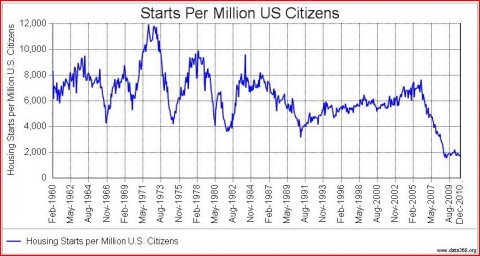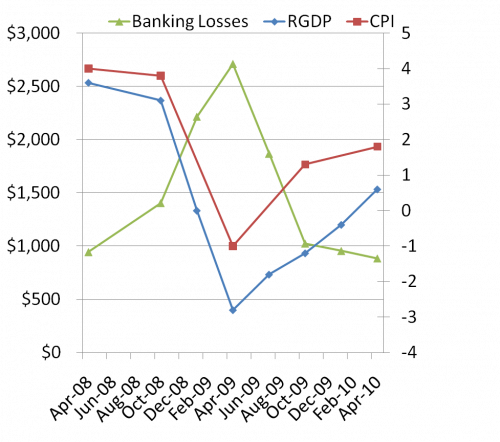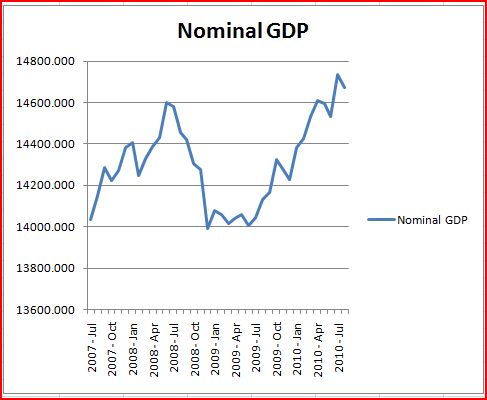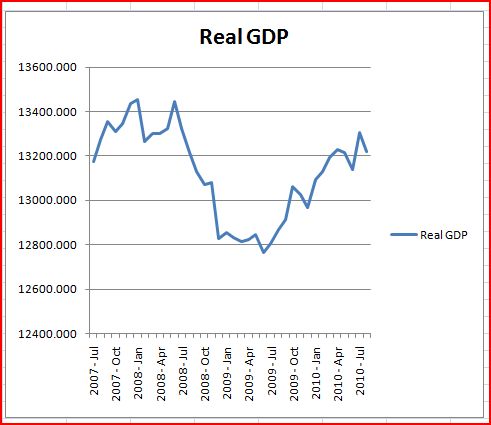We’re broke, therefore we should be booming
I see lots of discussion in the press about how the housing bubble made Americans poorer, and that this explains the low level of AD. Yet the conclusion doesn’t follow from the premise.
Every bone in my body tells me the conventional view is correct. We built too many houses and got too deeply in debt. Now we need to spend less, and that means we need to produce less (as trade is too small a share of GDP to make up the gap.) Intuitively this seems true, but it’s actually false. To see why, consider the following parable:
A pioneer family in the American Midwest has run into trouble. Locusts ate their wheat crop, and now they can’t pay back the local moneylender for the loan they used to get started in farming. He threatens to burn down their house if they don’t repay within another 12 months. What do they do? I’d argue they need to tighten their belts and consume less. They also need to work much harder. But in a closed economy (they are self-sufficient) how can this be? They consume what they produce. No, they consume part of what they produce. They need to consume less consumer goods. Since they are self-sufficient, money plays no role (and that means, THANK GOD, no NGDP shocks.) They need to “spend” less on clothing and pots, by spending less time making clothing and pots. And they need to spend more time clearing another 40 acres of land, by cutting down trees. They need to actually work harder, and plant twice as many crops as the year before.
You may not like the exports of wheat that are implicit in this example. Then assume the problem is poverty caused by locusts eating one half of their crops. Now they need to clear twice as much land to feed themselves, knowing the locusts will eat half of whatever they produce. Either way, they need to invest more. In an open economy they also made need to export more (depending on the situation in other “countries.”)
What’s true of the pioneer family is also true of the modern US economy. We need to tighten our belts by saving and investing more. But the Keynesians are wrong in assuming that more saving means less GDP. We need to have the Fed stabilize NGDP growth, so that more saving means more investment (and exports.)
A more sophisticated argument accepts this analysis as a long run proposition, but rejects it’s applicability for the US in 2008. People like Tyler Cowen and Arnold Kling might argue that a modern sophisticated economy can’t easily switch from producing one type of good to producing another. During the re-allocation of resources, and retraining of workers, there may be a good deal of unemployment. I accept this in principle, but believe the effect is so tiny as to not have important cyclical implications.
Perhaps the most famous example of the US finding itself producing the wrong set of goods occurred in late 1941. We had been producing lots of cars and other consumer products in our factories (the economy had mostly recovered from the Depression by December 1941.) And suddenly in late 1941 we realized that we needed to entirely stop producing any cars, and start producing tanks, airplanes, etc. And even worse, we had to do so with a largely untrained workforce, as a large share of our regular workforce was drafted into the military, and replaced by housewives, unskilled rural workers, etc.
So if re-allocation led to recession and high unemployment, then 1942 should have been the mother of all recessions. Obviously it wasn’t. And the reason is also obvious—NGDP rose sharply. Some might argue that we knew the new products we needed in 1942, but not in 2008. But I can’t see why that would be. The price system gives us the signals telling us what to produce, even without the sort of central planning we had in 1942. Keep NGDP growing at a steady rate, and booms will burst out in non-housing sectors. I said booms, not bubbles. This re-allocation is efficient, just like clearing land was efficient.
Another objection is that the Fed can’t prevent a fall in wealth from decreasing NGDP. So even if reallocation is not a problem, falling AD is. We had a near perfect laboratory test of this hypothesis in 1987. But first a bit of history. In 1929 there was a big stock market crash, and consumer spending fell sharply in 1930. This led many Keynesians to hypothesize that the stock crash actually caused the fall in AD during 1930. We now know that hypothesis is false, thanks to Alan Greenspan. This is because the 1987 crash was almost identical is size to 1929; if you overlay the two graphs for September/October, they line up almost perfectly. And because Greenspan kept NGDP growing at a steady rate, there was no collapse in consumer spending, and not even the teeniest slowdown in economic growth. Thus 1988 and 1989 were the two most prosperous years of the entire decade. Even the first half of 1990 saw very low unemployment. So the Keynesians were wrong about the Great Contraction.
Many people will send in comments to the effect that 1987 was different due to blah, blah, blah. And 1942 is not a good example of reallocation due to blah, blah, blah. Maybe you are right. But it won’t affect my views, because no one can point to a counterexample, that would disprove my “NGDP drives the cycle” hypothesis.
Someone needs to find a counterexample to the two following “it’s funnies”:
1. It’s funny that big drops in wealth never seem to result in recessions, unless the Fed lets NGDP growth slow sharply.
2. It’s funny that major episodes of re-allocation never seem to result in recessions, unless the Fed lets NGDP growth slow sharply.
For me, those two claims are the bottom line. We know what classical economics says should happen; I say it will happen if NGDP growth is stable. A commenter named Skip linked to an interview with Bob Lucas. Skip made the following observation:
In his interview when asked about his thoughts on Real Business Cycle theory he essentially says that he thinks RBC theory is basically right WHEN MONETARY POLICY IS GOOD.
Yep.
PS. Here’s the link Skip provided:
http://media.bloomberg.com/bb/avfile/Economics/On_Economy/vv9VRoc8DQl8.mp3
PPS. This exercise has made me a bit more accepting of the Keynesian argument that it’s time for lots more infrastructure. I was initially skeptical, as I assumed that good monetary policy would raise real rates back up to normal. Now I think they’d only go part way back to normal, at least for a while. Of course I’d hope we follow the Swedish lead and have the private sector build and operate as much of that infrastructure as possible. (So don’t worry Morgan, I’m not going soft.)





